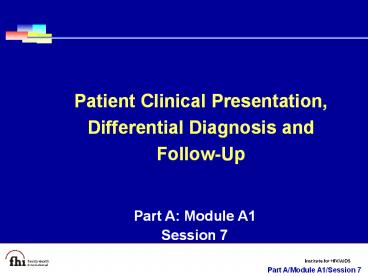Part A: Module A1 PowerPoint PPT Presentation
1 / 23
Title: Part A: Module A1
1
Patient Clinical Presentation, Differential
Diagnosis and Follow-Up
Part A Module A1 Session 7
2
Objectives
- Identify common disorders associated with HIV
infection - Diagnose HIV infection based on major and minor
signs and symptoms when CD4 cell counts are not
available - Diagnose HIV infection based on WHO laboratory
and clinical classification systems - List diseases that have a presentation similar to
HIV
3
Objectives, continued
- Discuss the importance of testing for HIV when
testing for these other diseases - Give examples of factors that help in making a
diagnosis - Discuss follow-up procedures in their local
situation
4
Outline of Session
- Patient Clinical Presentation
- Introduction
- WHO case definitions for HIV/AIDS surveillance in
countries with limited clinical and laboratory
diagnostic facilities - Differential Diagnosis and Follow-Up
- Differential diagnosis
- Follow-up visits
5
Patient Clinical Presentation
6
Introduction
- Diagnosing and staging HIV disease in a person
living in a resource limited country is not done
easily or quickly - A good clinical examination and thorough
interview of the patient is needed - WHO AIDS case definition and staging system is
useful it has been adapted for countries with
limited clinical and laboratory diagnostic
facilities - A further refinement of the WHO staging system is
also proposed for settings where laboratory
monitoring is not available
7
WHO Case Definitions
- Where HIV testing is not available, patients can
be diagnosed clinically based on major and minor
signs and symptoms
- Case definition for HIV/AIDS is fulfilled in the
presence of at least 2 major signs and at least 1
minor sign - Major signs (weight loss, chronic diarrhea,
prolonged fever) - Minor signs (persistent cough, herpes zoster,
oropharyngeal candidiasis, etc.)
The problem with this method is its low
sensitivity and specificity
8
WHO Case Definitions
- Where HIV testing is available
- The case definition for HIV/AIDS is fulfilled if
an HIV test is positive and one or more of the
following conditions is present
- Weight loss
- Cryptococcal meningitis
- Tuberculosis
- Kaposis sarcoma
- HIV encephalopathy
- Esophageal candidiasis
- Life threatening or recurrent pneumonia
- Invasive cervical cancer
9
WHO Clinical Staging System
- The WHO clinical staging system includes
- a clinical classification system
- a laboratory classification to categorize the
immunosuppression of adults by their total
lymphocyte counts - This staging system has proven reliable for
predicting morbidity and mortality in infected
adults - The WHO Clinical Staging System is based on
clinical markers believed to have prognostic
significance resulting in four categories
10
WHO Clinical Staging System
- Clinical Stage 1
- Asymptomatic infection
- Persistent generalized lymphadenopathy (PGL)
- Acute retroviral infection
- Clinical Stage 2
- Unintentional weight loss, lt 10
- Minor mucocutaneous manifestations
- Herpes zoster, within previous 5 years
- Recurrent upper respiratory tract infections
11
WHO Clinical Staging System
- Clinical Stage 3
- Unintentional weight loss, gt10
- Chronic diarrhea
- Prolonged fever
- Oral candidiasis
- Oral hairy leukoplakia
- Pulmonary tuberculosis
- Severe bacterial infections
- Vulvovaginal candidiasis
12
WHO Clinical Staging System
Clinical Stage 4
- PML (progressive multifocal leukoencephalopathy)
- Any disseminated endemic mycosis
- Candidiasis of the esophagus, trachea, bronchi,
and lungs - Atypical mycobacteriosis
- Non-typhoid Salmonella septicemia
- Extrapulmonary TB
- Lymphoma
- Kaposis sarcoma
- HIV encephalopathy
- HIV wasting syndrome
- PCP
- Toxoplasma of the brain
- Cryptosporidiosis with diarrhea
- Isosporiasis with diarrhea
- Extrapulmonary cryptococcosis
- Cytopmegaloviral disease of an organ other than
liver,spleen, or lymph node - Herpes simplex virus infection
13
WHO Clinical Staging System
- WHO Improved Clinical Staging System A further
refinement of the WHO clinical staging system
includes a laboratory axis. The laboratory axis
subdivides each category into 3 strata (ABC)
depending on the number of CD4 cells. If this is
not available, total lymphocytes can be used as
an alternative marker
14
Case Study
15
Differential Diagnosis and Follow-Up
16
Differential Diagnosis
- Initial diagnosis of HIV may be difficult
- The more general signs and symptoms of HIV are
common to many infections - Patients may have acquired both HIV and other
sexually transmitted or blood-borne diseases at
the same time - It is important to consider HIV testing when
testing for other infections that have similar
presentation
17
Differential Diagnosis
- The following diseases have a similar
presentation
- Epstein-Barr virus mononucleosis
- Cytomegalovirus mononucleosis
- Toxoplasmosis
- Rubella
- Syphilis
- Viral hepatitis
- Primary herpes simplex virus infection
- Disseminated gonococcal infection
- Other viral infections
18
Differential Diagnosis
- Examples of differentiating factors
- Epstein-Barr virus mononucleosis
19
Differential Diagnosis
- Ulcers
20
Differential Diagnosis
- Rash
21
Differential Diagnosis
- Laboratory tests can be used to determine the
diagnosis - (See Session 6 in Part A Module A1)
22
Follow-Up Visits
- After being informed about their results,
patients may need closer follow-up (weekly or
monthly) for psychological support and
informational needs - It is important that a system of referrals be
accessed and that the clinician does not fall
into three common errors of thinking - that they must provide for all of the patients
needs - that the patient only needs what they can provide
- that follow-up means care for acute problems only
- Once the relationship is established and the
patient understands his/her situation and the
condition is stable, the interval may be extended
to every 3 months
23
Follow-Up Visits, continued
- Should include the following tests
- Complete blood count every 3 months
- CD4 cell count or lymphocytes every 6 months
- Other examinations according to symptoms

